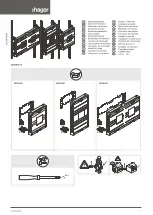
23
©2018 Hubbell Incorporated | Chance
®
Capstan Hoist Operating Instructions
Ten Safety Recommendations (Cont.)
NEVER USE A MALFUNCTIONING OR DAMAGED HOIST!
Before every job, thoroughly inspect the work site
and equipment to spot dangers. Inspect the hoisting
equipment for proper function. Check for damaged or
missing parts from previous jobs. Make sure all of the
equipment being used is rated for the loads involved.
THREE
BEWARE OF POTENTIAL DANGER ZONES AND
STAY CLEAR.
Arranging equipment or “rigging” for a job is extremely
important. Proper rigging makes a job easy. Improper
rigging can make a job unsafe. The crew must analyze
each job to determine the equipment required and the
possible location for each piece of equipment. Several
options may be available. Careful thought must be given
to choose the safest arrangement possible. Analyze the
forces, direction of those forces, and what can happen if
something breaks during the job.
Most objects are stronger in compression than tension or
bending. If you have a choice, use an item in compression.
For example, mount the bracket so the load pulls the
bracket against, instead of away from, the pole. This puts
less tension on the clamps. It is also better to pull in a
direction that is “in line” with a pole rather than a direction
that will try to turn the hoist and bracket “around” the
pole.
When steering clear of potential danger zones, the
proper choice of hoist, bracket, clamping means, rope,
blocks, slings, and gins are but a few of the items to be
considered. Take, for example, selection of a rope sheave.
If a single sheave rope block is used to lift a transformer
weighing 400 lb. it must be rated for 880 lb. minimum.
Why? The load (400 lb.) is pulling down on the block. At
the same time the hoist has to pull 400 lb. to lift the load.
This pull is also pulling down on the block. So 400 lb.
(load) plus 400 lb. (hoist pull) equals 800 lb. downward
load on the block. Friction will add additional load on the
block so that must be taken into account also. 10 percent
of the load is a rule of thumb that may be used for friction,
so 800 lb. plus 80 lb. (10%) equals 880 lb. The same is
true for a gin or sling used to support the block.
FOUR
















































